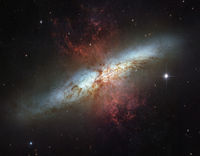Cigar Galaxy
 From Conservapedia
From Conservapedia | Cigar Galaxy | |
|---|---|

| |
| Observational Data | |
| Designation | Messier 82 NGC 3034 |
| Right ascension | 00h 55m 51s |
| Declination | +69° 40′ 43″ |
| Constellation | Ursa Major |
| Type of object | Spiral galaxy |
| Dimensions | 11.2 x 4.3'[1] |
| Magnitude | Apparent Mag: +8.41[1] Absolute mag: |
| Redshift | 0.00073±0.00009[2] |
| Astrometry | |
| Distance from Earth | 11.5 million light years[3] |
| Radial velocity | 203±4 km/s[2][3] |
The Cigar galaxy (M82, NGC 3034) is an galaxy in the constellation of Ursa Major and the M81 group, as well as the 82nd item in the Messier catalogue.[4] It was first observed by Johann Elert Bode in 1774 and rediscovered by Pierre Mechain in 1779.[5] It is situated near to another galaxy, M81, making it a popular target for amateur astronomers. Its name comes from its elongated shape, which looks like a cigar.
Environment and Structure[edit]
M82 was originally thought to be a type Irr II irregular galaxy. However, near-infrared photographs have shown two spiral arms.[3] These had never been observed as the galaxy is viewed edge on from Earth and the arms are obscured by dust within the galaxy. In fact, it is the brightest galaxy in the night sky.[4] It exhibits infrared excess, meaning that it emits more light in the infrared part of the spectrum than in the visible. It is also classified as a starburst galaxy due to its incredibly high rate of star formation.
The Cigar galaxy is approximately 38,000 light years across, contains many dust lanes and roughly 30 billion stars.[4] The Hubble Space Telescope has found over a 100 globular clusters in the Cigar galaxy as well as 197 star forming regions.[3][4] Star formation is believed to be at least 10 times that of the Milky Way. Three supernovae have also be observed. The supernova SN2014J, a type 1a, was one of the brightest supernovae observed in recent decades, reaching an apparent magnitude of 10.9.[3]
M82 is situated about 150,000 light years from M81, also known as Bode's galaxy.[5] The high volumes of star formation are due to tidal forces on M82, caused by its proximity to M81.
References[edit]
- ↑ 1.0 1.1 Cigar galaxy from messier-objects.com
- ↑ 2.0 2.1 M82 from simbad.u-strasbg.fr
- ↑ 3.0 3.1 3.2 3.3 3.4 Messier 82 from constellation-guide.com
- ↑ 4.0 4.1 4.2 4.3 M82 from messier.seds.org
- ↑ 5.0 5.1 Messier 82 from freestarcharts.com
| |||||||||||||||||
Categories: [Astronomy] [Galaxies] [Messier Objects]
↧ Download as ZWI file | Last modified: 02/19/2023 23:27:49 | 29 views
☰ Source: https://www.conservapedia.com/Cigar_Galaxy | License: CC BY-SA 3.0
 ZWI signed:
ZWI signed: KSF
KSF